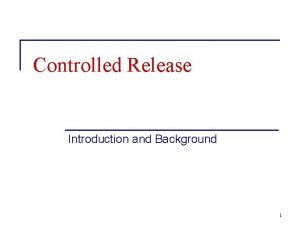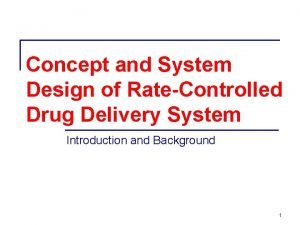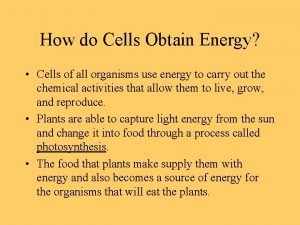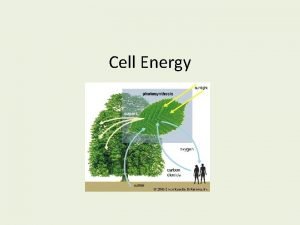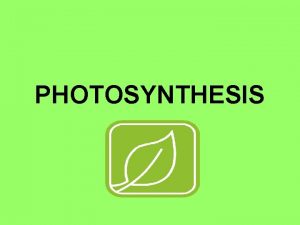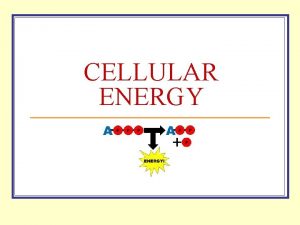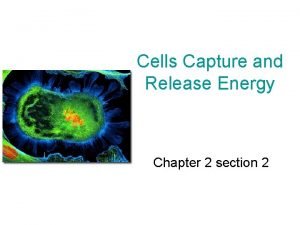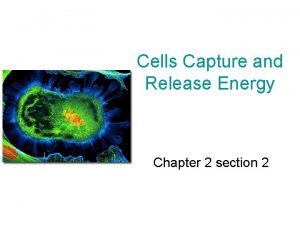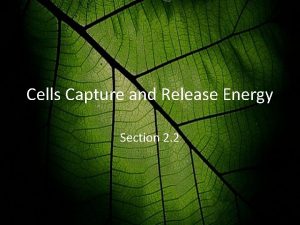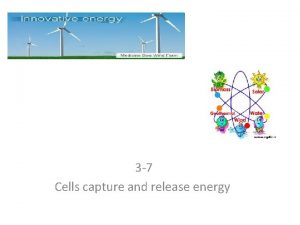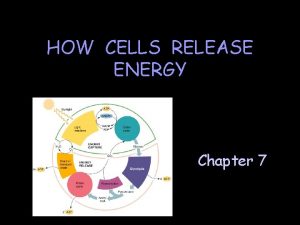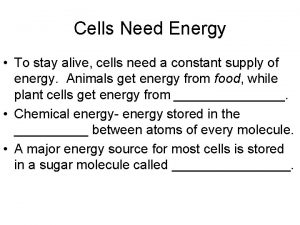CELLS CAPTURE AND RELEASE ENERGY ALL CELLS NEED









- Slides: 9

CELLS CAPTURE AND RELEASE ENERGY • ALL CELLS NEED ENERGY • SOME CELLS CAPTURE LIGHT ENERGY • ALL CELLS RELEASE ENERGY

ALL CELLS NEED ENERGY • Cells need a constant supply of energy (Plants from sun; Animals from food) • Chemical Energy: energy stored in bonds between atoms. • Glucose: main source of energy for most cells. • Cells use energy to carry out all of their activities.

SOME CELLS CAPTURE LIGHT ENERGY • Plants change Solar Energy into usable Chemical Energy (in glucose) by photosynthesis. • This takes place in CHLORPLASTS that have green chlorophyll (a light absorbing pigment that traps sun’s energy) • Plant takes in CO 2 and Water (H 2 O) • Energy from sun used to rearrange into GLUCOSE (sugar) and OXYGEN (released into air). • Plants can store glucose as large starch molecules (as in potato & carrot) to be used later or eaten by animals.


CELLS RELEASE ENERGY • Cellular Respiration = cells using O 2 to release energy stored in sugar (glucose); occurs mostly in the mitochondria • Glucose gets broken down (with O 2) into CO 2 and WATER; the exact opposite of photosynthesis • C 6 H 12 O 6 + 6 O 2 --- 6 H 2 O + 6 CO 2 + energy



Cells Release Energy Con’t. • FERMENTATION= cells release energy without oxygen (O 2); occurs entirely in the cytoplasm (not mito. ) • Alcoholic ferm. = Glucose alcohol + CO 2 + little energy; occurs in bread rising • Lactic acid ferm. = Glucose lactic acid + little energy; occurs in yogurt & cheese making

ENERGY AND EXERCISE • Muscle cells release ENERGY via cellular respiration & lactic acid fermentation • Normally muscles use OXYGEN (aerobic respiration) and release lots of ENERGY • In strenuous exercise, no time for oxygen, less energy released (tire out) and LACTIC ACID forms to irritate & “burn” muscle. • When you take a break, lactic acid gets broken down into CO 2 + H 2 O and burning sensation goes away.
 Immediate release dosage form
Immediate release dosage form Osmotic pump
Osmotic pump Extended release vs sustained release
Extended release vs sustained release How do cells obtain the energy they need
How do cells obtain the energy they need Do cells need energy
Do cells need energy Energy energy transfer and general energy analysis
Energy energy transfer and general energy analysis Energy energy transfer and general energy analysis
Energy energy transfer and general energy analysis Name all the rays
Name all the rays Force and work relationship quick check
Force and work relationship quick check Bonding continuum
Bonding continuum

